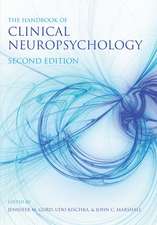Pathological Potential of Neuroglia: Possible New Targets for Medical Intervention
Editat de Vladimir Parpura, Alexei Verkhratskyen Limba Engleză Paperback – 24 sep 2016
| Toate formatele și edițiile | Preț | Express |
|---|---|---|
| Paperback (1) | 653.33 lei 6-8 săpt. | |
| Springer – 24 sep 2016 | 653.33 lei 6-8 săpt. | |
| Hardback (1) | 659.70 lei 6-8 săpt. | |
| Springer – 28 sep 2014 | 659.70 lei 6-8 săpt. |
Preț: 653.33 lei
Preț vechi: 768.62 lei
-15% Nou
Puncte Express: 980
Preț estimativ în valută:
125.01€ • 130.52$ • 103.47£
125.01€ • 130.52$ • 103.47£
Carte tipărită la comandă
Livrare economică 04-18 aprilie
Preluare comenzi: 021 569.72.76
Specificații
ISBN-13: 9781493955701
ISBN-10: 1493955705
Pagini: 541
Ilustrații: XVI, 541 p. 74 illus., 48 illus. in color.
Dimensiuni: 155 x 235 x 29 mm
Greutate: 0.78 kg
Ediția:Softcover reprint of the original 1st ed. 2014
Editura: Springer
Colecția Springer
Locul publicării:New York, NY, United States
ISBN-10: 1493955705
Pagini: 541
Ilustrații: XVI, 541 p. 74 illus., 48 illus. in color.
Dimensiuni: 155 x 235 x 29 mm
Greutate: 0.78 kg
Ediția:Softcover reprint of the original 1st ed. 2014
Editura: Springer
Colecția Springer
Locul publicării:New York, NY, United States
Cuprins
General Pathophysiology of Neuroglia: Neurological and Psychiatric Disorders as Gliopathies.- Ionic Signaling in Physiology and Pathophysiology of Astroglia.- Pathophysiology of Vesicle Dynamics in Astrocytes.- Glial Glutamate and Metabolic Transporters as a Target for Neurodegenerative Therapy and Biomarkers.- Alexander Disease and Astrotherapeutics.- Role of Astrocytes in Central Nervous System Traum.- Astroglial and Neuronal Integrity During Cortical Spreading Depolarization.- Crucial role for astrocytes in epilepsy.- Microglial Biology in Neuroinflammatory Disease: Pharmaco-industrial Approach to Target Validation.- The Role of Astrocytes in Huntington's Disease.- Amyotrophic Lateral Sclerosis: A Glial Perspective.- Complex and Associated Astroglial and Microglial Changes during the Progression of Alzheimer´s Disease.- Possible Therapeutic Targets in Microglia.- Novel Therapeutic Approaches to Malignant Gliomas.- Hepatic encephalopathy: A Primary Neurogliopathy.- Astroglia and Severe Mental Illness: A Role for Glutamate Microdomains.- Emerging Roles for Glial Pathology in Addiction.- Astroglial Connexins as Elements of Sleep-wake Cycle Regulation and Dysfunction.- Experimental Treatment of Acquired and Inherited Neuropathies.- Satellite glial cells as target for chronic pain therapy.- Enteric Glial Cells: Implications in Gut Pathology.
Recenzii
From the book reviews:
“This is comprehensive, up-to-date book on an often neglected area of neuroscience, neuroglia. It will provide interested readers with everything they need to know. Written and edited by an international team of researchers in the field, it is a welcome addition to the neurological and psychiatric literature.” (Michael Joel Schrift, Doody’s Book Reviews, February, 2015)
“This is comprehensive, up-to-date book on an often neglected area of neuroscience, neuroglia. It will provide interested readers with everything they need to know. Written and edited by an international team of researchers in the field, it is a welcome addition to the neurological and psychiatric literature.” (Michael Joel Schrift, Doody’s Book Reviews, February, 2015)
Notă biografică
Professor Alexei Verkhratsky, MD, PhD, D.Sc., Member of Academia Europaea, Member of the German National Academy of Sciences Leopoldina, Member of Real Academia Nacional de Farmacia (Spain), was born in 1961 in Stanislaw, Galicia, Western Ukraine. He graduated from Kiev Medical Institute in 1983, and received PhD (1986) and D.Sc. (1993) in Physiology from Bogomoletz Institute of Physiology, Kiev, Ukraine. He joined the Division of Neuroscience, School of Biological Sciences in Manchester in September 1999, became a Professor of Neurophysiology in 2002 and served as Head of the said Division from 2002 to 2004. From 2007 to 2010 he was appointed as a visitor professor/Head of Department of Cellular and Molecular Neurophysiology at the Institute of Experimental Medicine, Academy of Sciences of Check Republic. In 2010 A. Verkhratsky was appointed as a Research Professor of Ikerbasque (the Basque Research Council), in 2011 as an Honorary Visiting Professor at Kyushu University, Fukuoka, Japan and from 2012 he acts as Adjunct Scientific Director of the Achucarro Basque Centre for Neuroscience (Bilbao, Spain). Prof. A. Verkhratsky is a co-editor-in-chief of Cell Calcium (2000), and Membrane Transport & Signalling - Wiley Interdisciplinary Reviews (2009), Receiving Editor of Cell Death & Disease (2009) and a member of editorial boards of numerous scientific journals.
Vladimir Parpura, M.D., Ph.D., holds both a medical degree, awarded from the University of Zagreb in Croatia in 1989, and a doctorate, received in Neuroscience and Zoology from Iowa State University in 1993. He has held faculty appointments at the Department of Zoology and Genetics, Iowa State University and the Department of Cell Biology and Neuroscience, University of California Riverside. He is presently a tenured Associate Professor in the Department of Neurobiology, University of Alabama Birmingham, as well as a tenured Full Professor in the Department of Biotechnology, University of Rijeka, Croatia. He has been elected as a Member of Academia Europaea (MEA) in 2012. His current research includes: i) studying the modulation of calcium-dependent glutamate release from astrocytes in health and disease; ii) visualization of vesicular/receptor trafficking; iii) examination of the nature and energetics of interactions between exocytotic proteins using single molecule detection approaches; iv) development of scaffolds and dispersible materials, most notably modified carbon nanotubes, which can be used in repair after brain injury and v) bio-mimetic micro-robotics. He has been interfacing neuroscience with nanoscience/nanotechnology, synthetic biology and biomedical engineering.
Vladimir Parpura, M.D., Ph.D., holds both a medical degree, awarded from the University of Zagreb in Croatia in 1989, and a doctorate, received in Neuroscience and Zoology from Iowa State University in 1993. He has held faculty appointments at the Department of Zoology and Genetics, Iowa State University and the Department of Cell Biology and Neuroscience, University of California Riverside. He is presently a tenured Associate Professor in the Department of Neurobiology, University of Alabama Birmingham, as well as a tenured Full Professor in the Department of Biotechnology, University of Rijeka, Croatia. He has been elected as a Member of Academia Europaea (MEA) in 2012. His current research includes: i) studying the modulation of calcium-dependent glutamate release from astrocytes in health and disease; ii) visualization of vesicular/receptor trafficking; iii) examination of the nature and energetics of interactions between exocytotic proteins using single molecule detection approaches; iv) development of scaffolds and dispersible materials, most notably modified carbon nanotubes, which can be used in repair after brain injury and v) bio-mimetic micro-robotics. He has been interfacing neuroscience with nanoscience/nanotechnology, synthetic biology and biomedical engineering.
Textul de pe ultima copertă
Pathophysiological states, neurological and psychiatric diseases are almost universally considered from the neurocentric point of view, with neurons being the principal cellular element of pathological process. The brain homeostasis, which lies at the fulcrum of healthy brain function, the compromise of which invariably results in dysfunction/disease, however, is entirely controlled by neuroglia. It is becoming clear that neuroglial cells are involved in various aspects of initiation, progression and resolution of neuropathology. In this book we aim to integrate the body of information that has accumulated in recent years revealing the active role of glia in such pathophysiological processes. Understanding roles of glial cells in pathology will provide new targets for medical intervention and aide the development of much needed therapeutics. This book will be particularly useful for researchers, students, physicians and psychotherapists working in the field of neurobiology, neurology and psychiatry.
Caracteristici
Addresses the role of neuroglial cells in brain pathology Discusses the roles that glial cells could play as targets for medical therapies Can be used in advanced courses and seminars on glial pathophysiology Includes supplementary material: sn.pub/extras

















